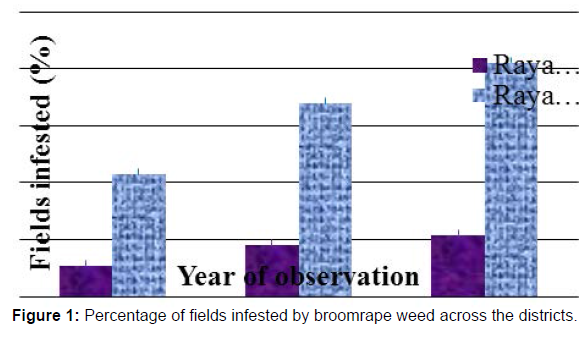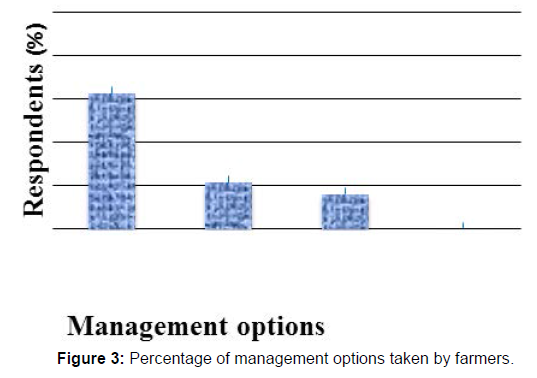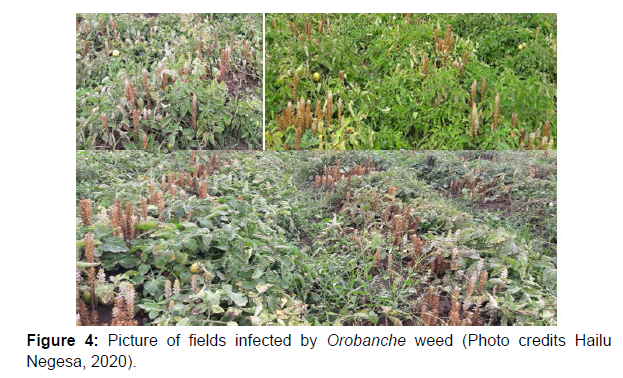Broomrape Weed (Orobanche spp.): An Emerging Threat of Tomato Production in Southern Tigray, Ethiopia
Received: 01-Jan-2022 / Manuscript No. acst-22-51783 / Editor assigned: 04-Jan-1970 / PreQC No. acst-22-51783 (PQ) / Reviewed: 18-Jan-1970 / QC No. acst-22-51783 / Revised: 24-Jan-1970 / Manuscript No. acst-22-51783 (R) / Accepted Date: 22-Jan-2022 / Published Date: 31-Jan-2022 DOI: 10.4172/2329-8863.1000493
Abstract
Broomrape weed is the most destructive parasitic weed in Ethiopia and Southern Tigray in particular. However, there was no profiled information about the weed in these areas. Therefore, the present observational study was conducted to roughly assess the distribution status of broomrape weed in southern Tigray. Results revealed that broomrape weed was prevalent up to 26.7%, 42.8% and 51.7% in 2017, 2018 and 2020 assessment years, respectively. Frequency of infested fields was higher in the Raya Azebo than in the Raya Alamata district across the years. Similarly, under peasant association level Kara Adisho and Warra Abbayye were highly severed by this weed. On the other hand, incidence of the weed had been not recorded in Limhat and Selam Bekalsi peasant associations across the years. In general, the study identified the importance of broomrape weed in southern Tigray. Meanwhile, future works should focus on the study of distribution, abundance and identification of the broomrape species prevailing in these areas. Besides, evaluation of integrated weed management options and awareness creation to stakeholders were mandatory to be done to tackle the bottleneck of tomato production in Southern Tigray.
Keywords
Broomrape weed; Frequency; Incidence; Prevalence
Introduction
Tomato (Solanum lycopersicum L.) is one of the most popular vegetable crops widely grown throughout the world [1]. It is the most important crop in the industrialized world and used as a key food and cash crop for farmers wherever it is produced. In Ethiopia, tomato has been given top priority research system and are considered as a high-value commodity crop. Despite its importance, the national yield of the crop was significantly low due to different biotic and abiotic constraints. Among the biotic constraints, broomrape weed is one of the most important constraints in Ethiopia [2]. It is the worst parasitic weed and causes an enormous reduction in the yield of the crop [3].
Broomrape weeds are obligate root parasitic plants from the genera of Orobanche and Phelipanche that can cause devastating damage to tomatoes and many other economically important broadleaf crops [4]. Broomrapes are holoparasites and only germinate in response to specific chemicals released by the host plant [5]. Several broomrape species have specialized in attacking and damaging vegetables and field crops in different parts of the world [6]. This weed spends most of its life cycle underground, where they undergo processes of germination, haustorial differentiation from the radicle, haustorial penetration of the host, formation of vascular connection with the host, acquisition of host nutrients, and storage of resources in a parasite organ called the tubercle or nodule [7]. Broomrape weeds greatly reduce productivity and sometimes kill the host [8]. Infection by Orobanche causes severe yield and quality losses [9]. The main threat of this weed originates from its high multiplication rate and the longer viability in the soil. A single plant of Orobanche can produce over 100,000 seeds that can survive in the field for up to 20 years [10]. Infection by Broomrape weed can cause yield losses of up to 75% .
In Ethiopia, up to 75% yield loss of tomato crop is reported due to Orobanche weed. Recently, the weed has been causing serious problems on tomato production in different parts of Ethiopia [11]. Accordingly, in Southern Tigray tomato production is constrained by the emerging threat of Broomrape weed. However, there is no profiled information about this weed in the area. Information on the occurrence, importance and abundance of the weed is crucial to formulate appropriate management strategies. Therefore, the present observational study was undertaken to roughly assess the distribution status of the weed in the Southern Tigray.
Materials and Methods
Description of the study area
The observational study was conducted in southern Tigray, Ethiopia. Southern Tigray is one of the seven administrative zones in the Tigray National Regional State. It is located in the southernmost boundary of the Tigray region bounded by the Afar region in the East, Eastern zone of Tigray in the North, Amhara Region in the South and South West. It lies 12o57’37’’.19 North latitude and 39o31’41’’.91 East longitude. The zone includes five districts namely, Raya-Alamata, Raya- Azebo, Ofla, Enda-Mekoni and Emba-Alaje. The study was conducted in Raya Alamata and Raya Azebo districts where the tomato crop is potentially prominent.
Occurrence and distribution of broomrape weed
The field assessment was conducted in 2017, 2018 and 2020 under the irrigation cropping system of the area starting from January to June. A total of 45 to 56 tomato fields were assessed for the occurrence of broomrape parasitic weed for three of the years. In each field, a pattern of an inverted W was followed to assess the presence or absence of the weed [12]. During 2020, farmers were interviewed for their perception about broomrape weed and their experience on the way to manage the weed.
Results and Discussion
Occurrence and distribution of broomrape weed
Broomrape weed was prevalent in both districts by different levels of tomato fields infested. The observational results have been shown that broomrape weed was more prevalent in Raya Azebo than in Raya Alamata district. Infestation of tomato fields was increasing from year to year in both assessed districts. Within three years the extent of infested fields was increased from 10.7 to 21.4 and 42.8 to 82.1 in Raya Alamata and Raya Azebo districts, respectively (Figure 1). Incidence of broomrape weed was varied across the assessed districts and years. Averagely around 26.7%, 42.8% and 51.7% tomato fields infested by broomrape weed were recorded from major tomato-producing areas of Southern Tigray in 2017, 2018 and 2020 cropping seasons, respectively.
Observation results indicated that the weed was 100% prevalent in Kara Adisho followed by Wara peasant association of Raya Azebo district during the 2018 and 2020 years. The highest incidence of the weed was recorded from Kara Adisho, Wara Abbayyee, Wergeba, Bagedelbo, Kulugize Lemlem and Gerjele peasant associations during 2020 with the mean of 100%, 85.7%, 71.4%, 71.4%, 71.4%, and 14.3%, respectively (Figure 2). Remarkable observation for three years has been shown that the number of fields infested by broomrape weed was alarmingly increasing across the peasant associations except Selam Bekalsi and Limhat where the incidence of the weed was not observed across the study years. Abundance of the weed was increased across the years on some fields of the study area (personal observation). This might be occurred due to the dissemination of the weed seed through farming tools, irrigation, contaminated planting materials and other ways from farm to farm gradually. In general, broomrape weed was widely disseminated in the Southern Tigray and causes great concern among the farmers.
Results indicated that around 62.5 % of farmers have no experience about the weed (Figure 3). In contrary way, 37.5% of farmers were properly understands the troublesome behavior of the weed and tried to manage the weed up to their experience. Accordingly, around 21.4% and 16.4% of respondents were used crop rotation and hand weeding, respectively. However, the farmers have the lack of knowledge on how to select and apply proper management options. According to the respondents, applied management methods were sourced from their previous experience on other non-parasitic weeds. This indicated the need of immediate intervention to manage the weed alarming distribution through creation of farmer’s awareness on how to fruitfully prevent the weed distribution and eradicate from infested fields (Figures 4).
Summary and Conclusion
In Broomrape weed was highly prevalent and important constraint of tomato production in southern Tigray. Frequency of infested fields was 51.7 in Southern Tigray. However, there was variation between districts and peasant associations of the study areas in distribution and abundance of the weed. The extent of the weed-infested field and its abundance has been doubled across the assessed years. Farmers of the study areas lack the experience to properly select management methods of the weed. In the study areas, some farmers were tried to use crop rotation and hand weeding to control the weed. However, they were not experienced on how to use the proper crop (non host crop) for rotation. In addition, they did not know the contribution of hand weeding to control the weed. The gap of information on the ways of the weed dissemination and selection proper management strategies in the study areas aggravates the problem of the weed in last years since its introduction to the areas. Therefore future works should be focused on:
• Detail study on the mapping of the weed distribution and abundance in the Southern Tigray.
• Identification of the broomrape species limiting tomato production of areas.
• Evaluation and recommendation of integrated management options.
• Training of the farmers to enrich the knowledge gap of the weed management
• Awareness creation to agricultural experts and local administration to prevent introduction to un-infested fields.
References
- Negesa H, Ayana G (2021) Spatial Distribution of Tomato Early Blight and Reaction of Some Tomato Varieties to the Disease in Southern Tigray, Ethiopia. J Plant Pathol 12:584.
- Mariam EG, Suwanketnikom R (2004) Screening of tomato (Lycopersicon esculentum Mill.) varieties for resistance to branched broomrape (Orobanche ramosa L.). Agric Nat Resour 38:434-439.
- Lopez-Raez JA, Charnikhova T, Mulder P (2008). Susceptibility of the tomato mutant high pigment-2dg (hp-2dg) to Orobanche spp. infection. J Agric Food Chem 56: 6326-6332.
- Osipitan OA, Hanson BD, Goldwasser Y (2021) The potential threat of branched broomrape for California processing tomato: A review. Calif Agric 75:43-45.
- Habimana S, Nduwumuremyi A, Chinama R (2014) Managementof orobanche in field crops: A review. J Soil Sci Plant Nutr 14:43-62.
- Parker C (2009) Observations on the current status of Orobanche and Striga problems worldwide. Pest Manag 65:453-459.
- Fernández-Aparicio M, Rubiales D (2011) Differential response of pea (Pisum sativum) to Orobanche crenata, Orobanche foetida and Phelipanche aegyptiaca. Crop Prot. 31:27-30.
- Fernandez-Aparicio M, Sillero JC, Rubiales D (2009). Resistance to broomrape species (Orobanche spp.) in common vetch (Vicia sativa L.). Crop Prot: 28-7-12.
- Iasur Kruh L, Lahav T, Abu-Nassar J (2017) Host-Parasite-Bacteria Triangle: The Microbiome of the Parasitic Weed Phelipanche aegyptiaca and Tomato-Solanum lycopersicum (Mill.) as a Host. Front. Plant Sci 8:269.
- Ahmad T, Ahmad B, Tariq R, Syed M (2018) Assessment of the yield loss imparted by Orobanche aegyptiaca in tomato in Pakistan. An Acad Bras Cienc 90:3559-3563.
- Abebe G, Sahile G, Al-Tawaha M. (2005) Evaluation of potential trap crops on Orobanche soil seed bank and tomato yield in the central rift valley of Ethiopia. World J Agric Res 1:148-151.
- Thomas AG (1985). Weed survey system used in Saskatchewan for cereal and oilseed crops. Weed Sci, 33:34-43.
Google Scholar, Crossref, Indexed at
Google Scholar, Crossref, Indexed at
Google Scholar, Crossref, indexed at
Google Scholar, Crossref, Indexed at
Google Scholar, Crossref, Indexed at
Google Scholar, Crossref, Indexed at
Google Scholar, Crossref, Indexed at
Citation: Negesa H (2022) Broomrape Weed (Orobanche spp.): An Emerging Threat of Tomato Production in Southern Tigray, Ethiopia. Adv Crop Sci Tech 10: 493. DOI: 10.4172/2329-8863.1000493
Copyright: © 2022 Negesa H. This is an open-access article distributed under the terms of the Creative Commons Attribution License, which permits unrestricted use, distribution, and reproduction in any medium, provided the original author and source are credited.
Select your language of interest to view the total content in your interested language
Share This Article
Recommended Journals
Open Access Journals
Article Tools
Article Usage
- Total views: 4383
- [From(publication date): 0-2022 - Dec 04, 2025]
- Breakdown by view type
- HTML page views: 3647
- PDF downloads: 736




